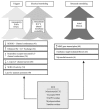Atrial fibrillation in the elderly: the potential contribution of reactive oxygen species
- PMID: 23341843
- PMCID: PMC3545256
- DOI: 10.3724/SP.J.1263.2012.08141
Atrial fibrillation in the elderly: the potential contribution of reactive oxygen species
Abstract
Atrial fibrillation (AF) is the most commonly encountered cardiac arrhythmia, and is a significant source of healthcare expenditures throughout the world. It is an arrhythmia with a very clearly defined predisposition for individuals of advanced age, and this fact has led to intense study of the mechanistic links between aging and AF. By promoting oxidative damage to multiple subcellular and cellular structures, reactive oxygen species (ROS) have been shown to induce the intra- and extra-cellular changes necessary to promote the pathogenesis of AF. In addition, the generation and accumulation of ROS have been intimately linked to the cellular processes which underlie aging. This review begins with an overview of AF pathophysiology, and introduces the critical structures which, when damaged, predispose an otherwise healthy atrium to AF. The available evidence that ROS can lead to damage of these critical structures is then reviewed. Finally, the evidence linking the process of aging to the pathogenesis of AF is discussed.
Keywords: Aging; Arrhythmia; Atrial fibrillation; Cardiac; Free radicals; Oxidative stress; Redox.
Figures


References
-
- Naccarelli GV, Varker H, Lin J, et al. Increasing prevalence of atrial fibrillation and flutter in the United States. Am J Cardiol. 2009;104:1534–1539. - PubMed
-
- Davis RC, Hobbs FDR, Kenkre JE, et al. Prevalence of atrial fibrillation in the general population and in high-risk groups: the ECHOES study. Europace. 2012 [Epub ahead of print]. Available from: http://www.ncbi.nlm.nih.gov/pubmed/22490371. - PubMed
-
- Kim MH, Johnston SS, Chu BC, et al. Estimation of total incremental health care costs in patients with atrial fibrillation in the United States. Circ Cardiovasc Qual Outcomes. 2011;4:313–320. - PubMed
-
- Kannel WB, Wolf PA, Benjamin EJ, et al. Prevalence, incidence, prognosis, and predisposing conditions for atrial fibrillation: population-based estimates. Am J Cardiol. 1998;82(8A):2N–9N. - PubMed
Grants and funding
LinkOut - more resources
Full Text Sources
Other Literature Sources
